|
MAN AND MYTH
| INTRODUCTION
A look at how much is known about William Wallace and what is just myth. With any history covering a time over 7 centuries ago there will never be huge amounts of recorded evidence and Wallace's story is no different. As he was not of noble or royal birth, there is even less evidence available. Even where evidence does exist it can be interpreted differently, or its accuracy disputed.
|

Figure of Wallace, created for 1997 Wallace exhibition © Stirling Smith Art Gallery & Museum
|
Little that is hard fact is known about William Wallace. Where he was born, when he was born, who his parents were, if he was married - these details are all open to speculation and a certain amount of educated guesswork.
|
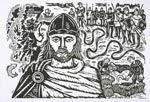
William Wallace - Scotland's Liberator, by Owain Kirby© Stirling Smith Art Gallery & Museum
|
Born - While his date of birth is taken as 1272 in many sources, there is no firm evidence to support any date. Indeed a range of dates of 1260 to 1278 have been used, that's 18 years of a difference!
Father - His father is generally taken to be Sir Malcolm Wallace of Elderslie in Paisley. He was a descendant of a Richard Wallace, or "le Waleis" " the Welshman - who had come to Scotland to serve in the royal household of King David I in the early part of the 12th century. Blind Harry states that Sir Malcolm was William Wallace's father. However, there is evidence that his father might have been another man: Alan Wallace. Wallace's seal on the "Lubeck Letter", the letter Wallace and Andrew Murray sent as Guardians in 1297, says "William, son of Alan Wallace". There is also an Alan Wallace on the Ragman Roll. (The Ragman Roll being the record of those Scottish landowners who swore loyalty to Edward I in 1296.) As this Alan Wallace is listed on the Roll as being from Ayr, it could be that William Wallace may well have been born in Ellerslie, which is near Kilmarnock, and not Elderslie near Paisley.
Family - It is known that Wallace had 2 brothers: Malcolm and John who were also involved in the struggle. John died in London in similar circumstances to that of his brother.
Marriage - It is not known for certain if William Wallace was married or not, or if he had children. His killing of the Sheriff of Lanark in 1297 is believed to have been as vengeance for the murder of his wife, Marion Braidfute.
|
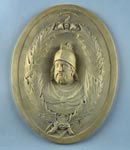
William Wallace © Paisley Museums & Art Gallery
|
Physical Appearance
|

Face and Helmet of the Dryburgh Wallace Statue by Graciela Ainsworth © Graciela Ainsworth
|
One section of the Scotichronicon from the 14th century, does give this description of Wallace: "He was a tall man with the body of a giant, cheerful in appearance with agreeable features, broad-shouldered and big-boned, with belly in proportion and lengthy flanks, pleasing in appearance but with a wild look, broad in the hips, with strong arms and legs, a most spirited fighting-man, with all his limbs very strong and firm."
|
Although many portraits and representations have been done of Wallace over the years we don't know exactly what he looked like. There were no portraits done of him during his life. A sketch made by the 11th Earl of Buchan in the 19th century (which is the property of the Scottish National Portrait Gallery) is reputed to have been drawn from an original medieval piece of artwork although this original has been lost. This engraving is based on that sketch.
|
 |
|
Engraved Portrait of Sir William Wallace © Mitchell Library |
Many other depictions of Wallace have been made over the years all similar in approach, showing him as a determined man. Many portraits of Wallace show him wearing the "dragon" helmet, which wasn't of the time, but several centuries later. The dragon symbol is thought to refer to Wallace's family origins in Wales.
|
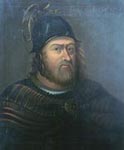
Portrait of Sir William Wallace © Stirling Smith Art Gallery & Museum
|
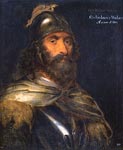
William Wallace by George Jamesone (c1589-1644) © Private Collection
|
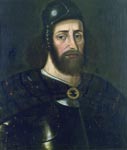
William Wallace by a Follower of Jamesone © Chris James
|
|
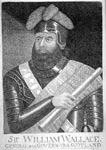
Engraved Portrait of Sir William Wallace, General and Governor of Scotland 1300 by John Kay © Stirling Smith Art Gallery & Museum
|

Engraved portrait of Sir William Wallace © Stirling Smith Art Gallery & Museum
|
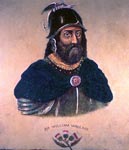
William Wallace by an unknown artist © Private Collection
|
However, some representations are perhaps more comic than dramatic and whether they do Wallace justice should be left to the viewer to decide...
|

William Wallace Staffordshire figure © T A Devlin
|
Height
|
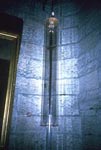
Wallace Sword © Stirling Smith Art Gallery & Museum
|
One of the main aspects that draws much attention is that of Wallace's height. He is regarded as being tall, as high as 6ft 7inches. This is based on the documents and histories that were passed down describing him and also on the speculation that he would have had to have been tall to wield so effectively the sword that is kept in the Wallace National Monument at Abbey Craig just outside Stirling. The sword is 5 feet 4 inches (162 cm) long and so its user would have needed to be both tall and strong to use it properly in battle. As there are no remains with which to verify the claims, we will just have to stay with the notion that he was literally a giant of a man.
|
What kind of person was he?
As so little is recorded of what he said and much of what is written about him describes his military prowess, it is not easy to find out what type of person Wallace was. It can be assumed that anyone who pursued his aims so determinedly for a decade in the most trying of situations must have been a very strong character. Anyone who was able to go from being an outlaw to commanding a large field army, from early summer to September in 1297 at the Battle of Stirling Bridge must have been a remarkable person, shrewd and able to adapt and learn quickly. It should also be remembered that Wallace was not of noble birth and not like Robert the Bruce, who had grown up knowing he was born to lead.
|
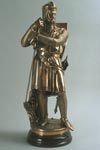
Wallace figure by Elkington of Birmingham ©Stirling Smith Art Gallery & Museum
| Back to top
From Blind Harry to Braveheart
|
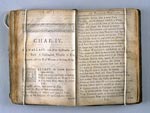
Translation of Blind Harry © Bob McCutcheon
|
If Blind Harry's "The Wallace" was the popular telling of Wallace's life in the centuries before the 21st, the 1995 film "Braveheart" is the most well-known in the years following.
|
|
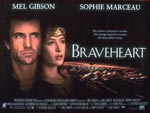
Poster for the film Braveheart © 20th Century Fox
|
Directed by Mel Gibson, who also starred in it as William Wallace, it was written by American screenwriter Randall Wallace, who only became aware of his famous namesake while visiting Edinburgh Castle and spotting a statue of a heroic figure called "Wallace."
|
It was released in 1995 and was a huge popular and critical success. It won 5 Oscars and grossed over $200 million on its way to being the 13th highest earning film worldwide in 1995. The film had its European premiere at the MacRobert Arts Centre in Stirling followed by a reception at Stirling Castle.
|
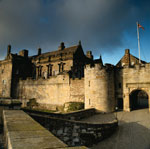
Stirling Castle exterior, Stirling © James Gardiner
|
There is no doubt that in typical Hollywood style, "Braveheart" does not keep strictly to the facts of William Wallace's life or the campaigns he led. The film's scenes shot in Scotland were filmed in Glen Nevis, even though Wallace operated mainly out of the forest at Selkirk and was from the lowlands. Some of the more historical aspects include characters that are invented, (the nobles Lochlan, Mornay, and Craig) or real ones have their names changed (Wallace's wife Marion is "Murron" in the film, as the film-makers did not want to confuse viewers with the heroine in Robin Hood's story). The chief historical area that is at odds with the facts is that of the French Princess Isabella, who did not become Prince Edward's wife until January 1308, two and half years after William Wallace's death. As she was only born in 1292 (or 1295) she would only have been 10 or 13 when he was executed and not the adult woman depicted in the film.
|
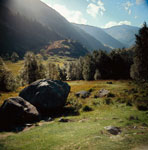
Glen Nevis, Highlands © James Gardiner
|
|
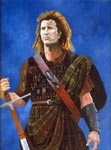
Mel Gibson as William Wallace in Braveheart © David McCarroll
|
Some of the most easily picked up visual features criticised in the film are the woad worn at the Battle of Stirling; the kilts which would only be worn by highlanders; and even the haircut of Wallace. Interestingly, in Blind Harry's Wallace of 1477 there is a passage where Wallace, in a dream, is visited by a queen who "with a sapphire cross'd his face".
|
However, there are many parts of Braveheart that capture the known history: Edward I's dismissive approach to Scotland and in particular his attitude to the squabbling, self-seeking nobles; the prevaricating and switching allegiances of the young Robert the Bruce; the start of Wallace's rebellion due to him killing an English sheriff; the gathering force of his popular rebellion leading to the Battle of Stirling Bridge (if without the bridge itself); the defeat at Falkirk where the Scottish nobles did desert the field and were blamed for the defeat; and the abrupt nature of his "trial" in England, amongst others.
|
And there are also aspects to the story that are powerfully depicted in the film. In particular, the final scene with the now single-minded Robert the Bruce leading his army at Bannockburn, where he inspires his troops to victory with the words "You have bled with Wallace, now bleed with me." This echoes the first lines of Robert Burns' "Scots Wha Hae": "Scots, wha hae wi' Wallace bled, Scots, wham Bruce has aften led."
|
The film-makers were perfectly aware of the inconsistencies between the known facts and the story they were telling. Reference is made during the preamble to the Battle of Stirling Bridge when one of the Scottish soldiers sees Wallace for the first time and says to his companion: "Can't be [Wallace] " he's not tall enough." It could be that with a historical figure around whom little is known for sure, the maxim "When the legend becomes fact, print the legend" was applied. And with so little properly known, there is so much space to fill in that it's inevitable licence would be taken with the "truth". Mel Gibson said about Braveheart: "We adhered to history where we could but hyped it up where the legend let us".
|
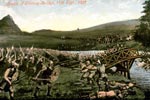
Battle of Stirling Bridge postcard © Stirling Smith Art Gallery & Museum
|
|
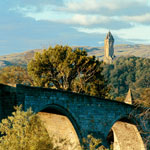
Stirling Old Bridge and Wallace Monument, Stirling © James Gardiner
|
There can be no doubt that "Braveheart" has benefited Scotland. Deputy Tourism and Culture Minister Dr Elaine Murray said at the launch of the Pocket guide To Scottish film in 2002: "Braveheart stimulated a huge interest in William Wallace and served as a great advertisement for Scotland. Over 20% of American tourists to Scotland in the year following the release of the film cited it as one of the reasons for choosing a trip to Scotland. At the same time visitor figures to the Wallace Monument in Stirling doubled."
|
While there are many historical inaccuracies in the film, it would not have been possible to make a film based completely on the truth, as there is no agreement on what is the truth apart from a few scant details. What is accurate is that his legacy survives. To give some idea of the continuing high profile, William Wallace received a significant share of the votes in the Scran Great Scots of the 20th Century poll in 2002 " despite him having died in the 14th century! Back to top
|
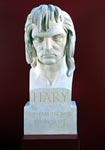
Bust of Blind Harry by Alexander Stoddart © Stirling Smith Art Gallery & Museum
|
There are, however, a number of sources which are generally relied on to tell the story of his life and deeds. The most well-known is that of Blind Harry, from which much of Wallace's history stems. Blind Harry's account is called "Acts and Deidis of the Illustre and Vallyeant Campioun Schir William Wallace/ Acts and Deeds of the Illustrious and Valiant Champion Sir William Wallace of Elderslie", but is often shortened to "The Wallace".
|
Written several centuries later (Blind Harry entertained the court of James IV) it was one of the first books published in Scotland, by Chapman and Myllar in 1507. It was republished many times and it was through Blind Harry's work that Robert Burns and millions of other Scots through the ages read about and were much affected by the heroic tales of Wallace. Blind Harry was said to have based his tales of Wallace on John Blair's "Life of Wallace." Blair knew Wallace personally and was his chaplain. Unfortunately no copy of this document survives, although it is speculated that there could be a version hidden in the Papal archives in the Vatican, as it was written by Blair to be submitted to Pope Boniface.
|
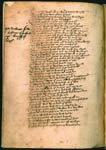
Manuscript of Blind Harry's 'The Wallace' © National Library of Scotland
|
|
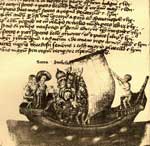
Manuscript illustration (facsimile copy) from John of Forduns Scotichronicon © National Museums of Scotland
|
There were other histories written many hundreds of years ago that have also survived and which refer to Wallace. Andrew of Wyntoun (1350-1424), Prior of Lochleven, wrote the "Original Chronicle" and John of Fordun (unknown -1385) and Walter Bower (1385-1440), Abbot of Inchcolm in the Firth of Forth, jointly wrote the "Scotichronicon" which was written nearer to Wallace's lifetime than that of Blind Harry. As time had passed since Wallace's life, we cannot know for certain how much of the truth was available to them.
| Back to top
|
|







